Juniper jn0-663 practice test
Service Provider Routing and Switching, Professional (JNCIP-SP) Exam
Question 1
Exhibit.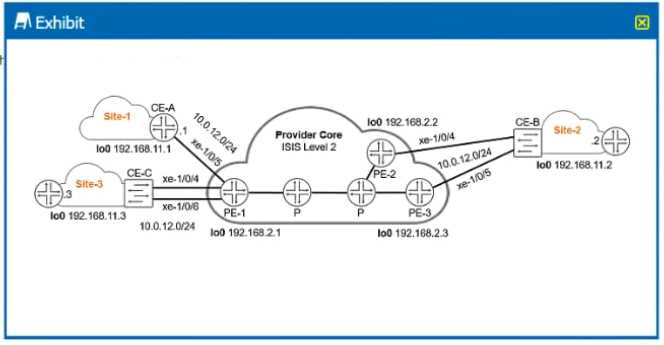
You have the LDP signaled VPLS topology as shown in the exhibit CE-B at Site-2 is multihomed to
both PE-2 and PE-3
In this scenario where would you configure loop prevention?
- A. PE-2
- B. PE-3
- C. CE-B
- D. PE-1
Answer:
D
Question 2
Which two statements are correct about Opaque LSAs in OSPF? (Choose two )
- A. Type 9 LSAs are used for graceful-restart and have link-local scope
- B. Type 11 LSAs are used for MPLS label exchange and have link-local scope
- C. Type 10 LSAs are used for MPLS traffic-engineering and have area scope.
- D. Type 11 LSAs are used for MPLS traffic-engineering and have area scope
Answer:
A, B
Question 3
Exhibit.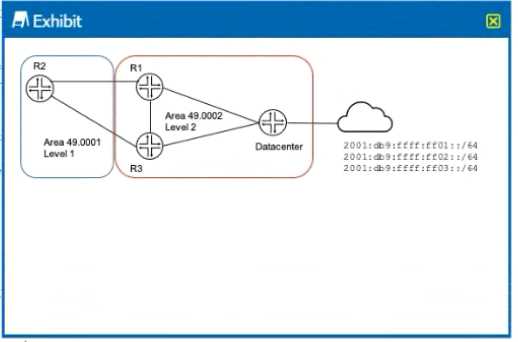
A network designer wants to ensure that traffic from R2 destined for 2001 db9:ffff:ff00. '62 always
traverses the R2-R1 link it that link is available
Referring to the exhibit, which configuration change will satisfy this requirement?
A)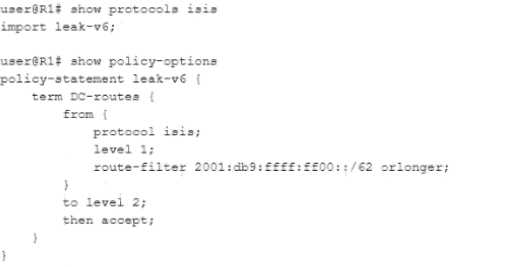
B)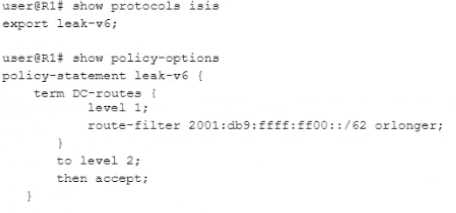
C)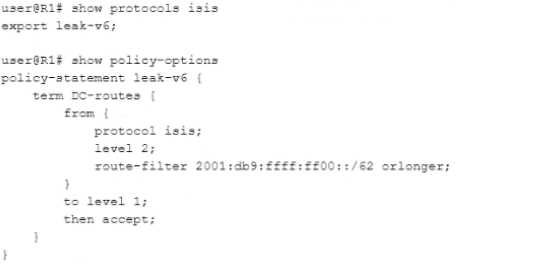
D)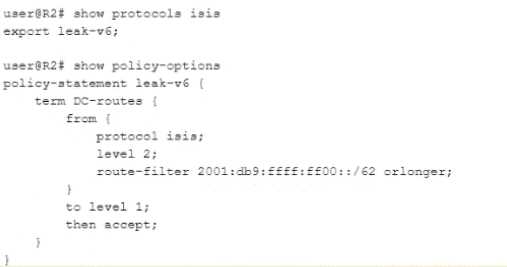
- A. Option A
- B. Option B
- C. Option C
- D. Option D
Answer:
C
Question 4
Exhibit.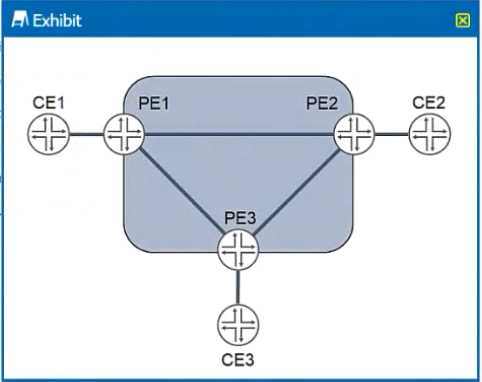
You are provisioning Layer 2 circuits between sites CE1. CE2. andCE3
Referring to the exhibit, which statement is true?
- A. Two VLANs must be configured from PE1 to CE1.
- B. A point-to-multipoint LSP must be created between sites.
- C. Site PE1 must have a point-to-multipoint link configured towards the core
- D. Each site must have only one VLAN configured to the PE
Answer:
A
Question 5
Exhibit.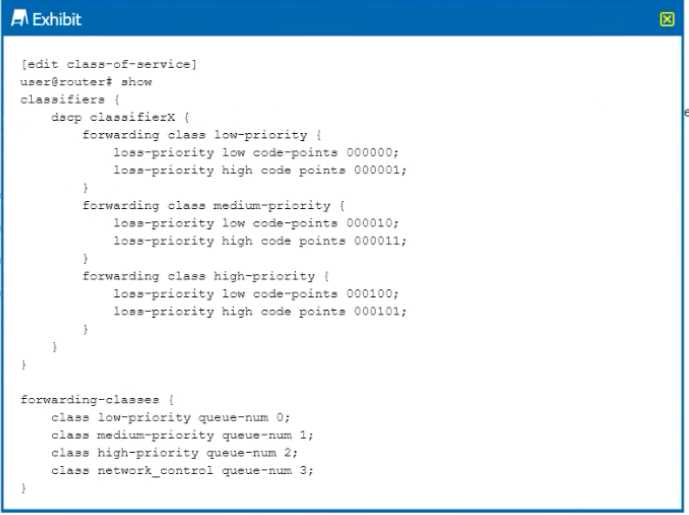
You manage an MX Series device which includes the configuration shown in the exhibit Traffic
marked with DSCP 000011 is entering the ge-1/0'4 interface at 102 Mbps The traffic exits the device
on the ge-1 '0/5 interface No other traffic is transiting the router
In this scenario what happens to traffic exceeding 100 Mbps?
- A. Traffic exceeding 100 Mbps is redirected to a rate limiter.
- B. Traffic exceeding 100 Mbps Is buffered
- C. Traffic exceeding 100 Mbps is forwarded.
- D. Traffic exceeding 100 Mbps is dropped
Answer:
C
Question 6
Exhibit.
A customer wants to reduce LSP flooding in their IS-IS network
Which parameter should you change to accomplish this task?
A)
B)
C)
D)
- A. Option A
- B. Option B
- C. Option C
- D. Option D
Answer:
B
Question 7
You are deploying a new EVPN service for your customers. You must build the service based on the
following requirements
-- both Layer 2 and Layer 3 functionality must be supported
-- your customers must be able to support multiple VLANs in the same EVPN instance (EVI).
In this scenario which two types of routing instances should be configured? (Choose two.)
- A. VRF
- B. virtual switch
- C. virtual router
- D. EVPN
Answer:
A, D
Question 8
Which two types of LSAs have an area scope? (Choose two)
- A. Type5
- B. Type 2
- C. Type 7
- D. Type 11
Answer:
B, D
Question 9
Exhibit.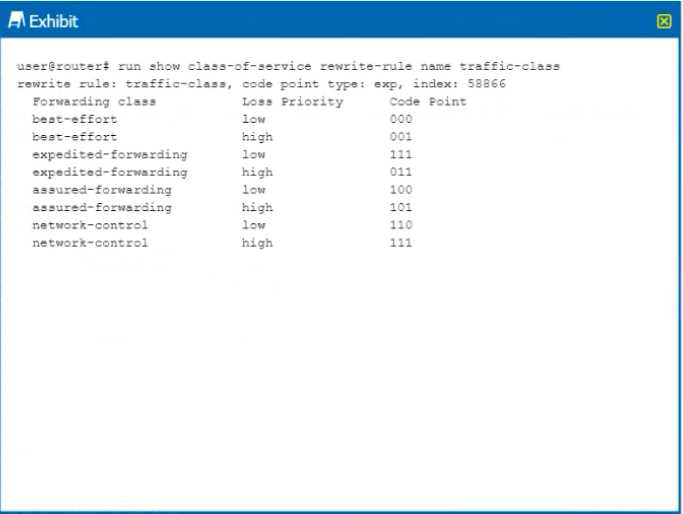
Your router should be configured with a rewrite rule which alters the default behavior of expedited
forwarding as shown in the exhibit
In this scenario which configuration is correct?
A)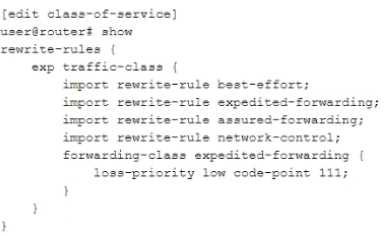
B)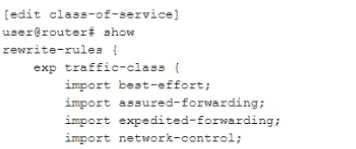
C)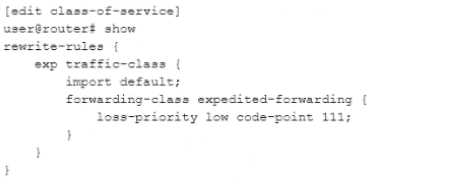
D)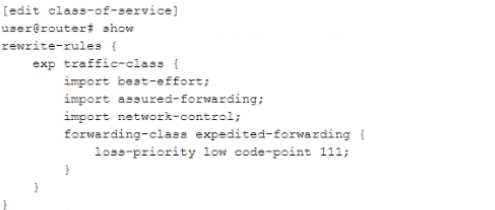
- A. Option A
- B. Option B
- C. Option C
- D. Option D
Answer:
C
Question 10
Exhibit.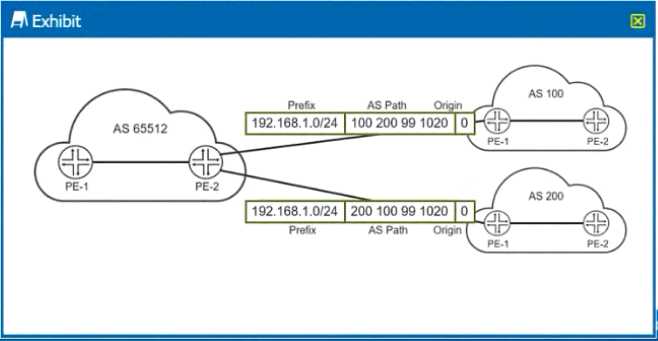
You are the administrator of AS 65512 You are learning the 192 168 1 0/24 prefix from both AS 100
and AS 200 You want traffic destined to the 192 168 1.0.0/24 prefix to exit your AS towards AS 200
How would you accomplish this task'?
- A. Configure an import routing policy on PE-2 to modify the origin attribute on the path learned from AS 100
- B. Configure an import routing policy on PE-2 to append the AS path attribute on the path learned from AS 100
- C. Configure an import routing policy on PE-2 to set a higher MED on the path learned from AS 100
- D. Configure an import routing policy on PE-2 to set a higher local preference value on the path learned from AS 200
Answer:
D
Question 11
You are establishing a Layer 3 VPN between two PE devices Currently you have a single internal IPv4
BGP peering between the PE devices. You must ensure that the IPv4 and IPv6 routes from both CE
devices are exchanged between these sites
Which two statements are correct in this scenario? (Choose two.)
- A. You must establish an IPv6 BGP peering between the two PEs
- B. You must enable the inet-vpn NLR on both PE devices.
- C. You must enable the inet6-vpn NLRI on both PE devices.
- D. You must enable IPv6 tunneling on the LSPs between the PE devices
Answer:
B, C
Question 12
Exhibit.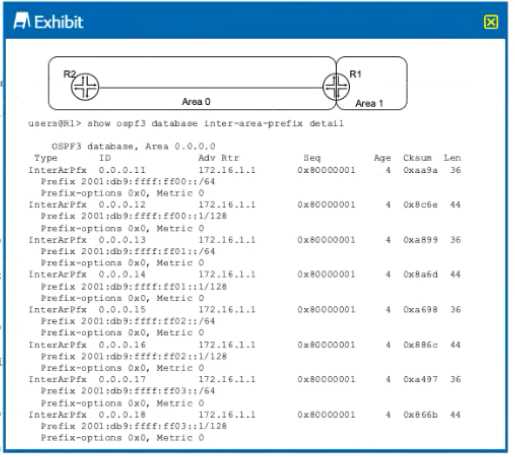
Referring to the exhibit, which command would reduce the size of the OSPF database and
corresponding routes?
A)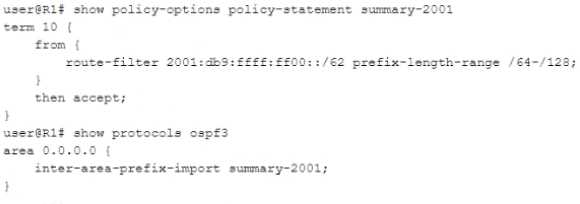
B)
C)
D)
- A. Option A
- B. Option B
- C. Option C
- D. Option D
Answer:
D
Question 13
Exhibit.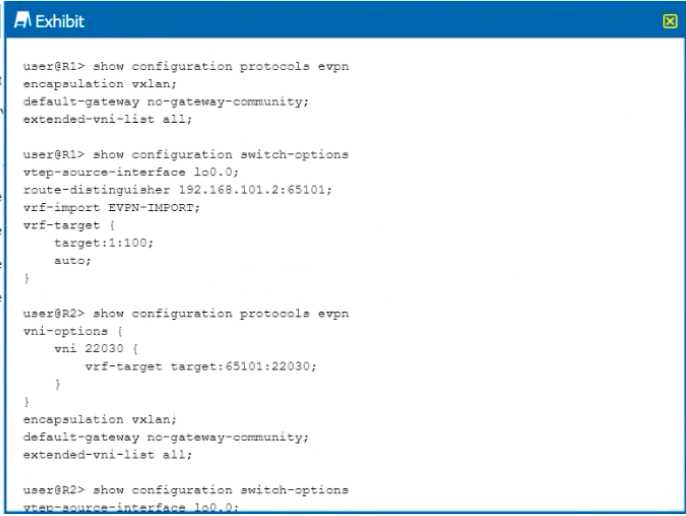
You are using EVPN to provide Layer 2 stretched VLANs between two sites You notice that the MAC
addresses in either site are not showing up on the remote site.
Referring to the exhibit, what are two ways to solve this problem? (Choose two )
- A. On R1, issue the sec 3wicch-cpt:.cr.3 vrf-target target: 65101:22030 Command
- B. On R2 issue the set protocols evpn vni-options vni 22030 command
- C. On R1, issue the sec protocols evpn vni-options vni 22030 vrf-target target:65101:22030 command
- D. On R2, issue the set switch-options vrf-target target: 65101:22030 command
Answer:
A, D
Question 14
Which two statements about wide and narrow metrics used in IS-IS are correct? (Choose two)
- A. Wide metrics are sent by default and use 24 bits in TLVs to send information
- B. Narrow metrics are enabled by default and use 8 bits in TLVs to send information
- C. Disabling narrow metrics results in external routes being leaked from L1 to L2 areas automatically
- D. Wide metrics are enabled with the wide-metrics-or.ly parameter under protocols IS-IS hierarchy.
Answer:
B, C
Question 15
Exhibit.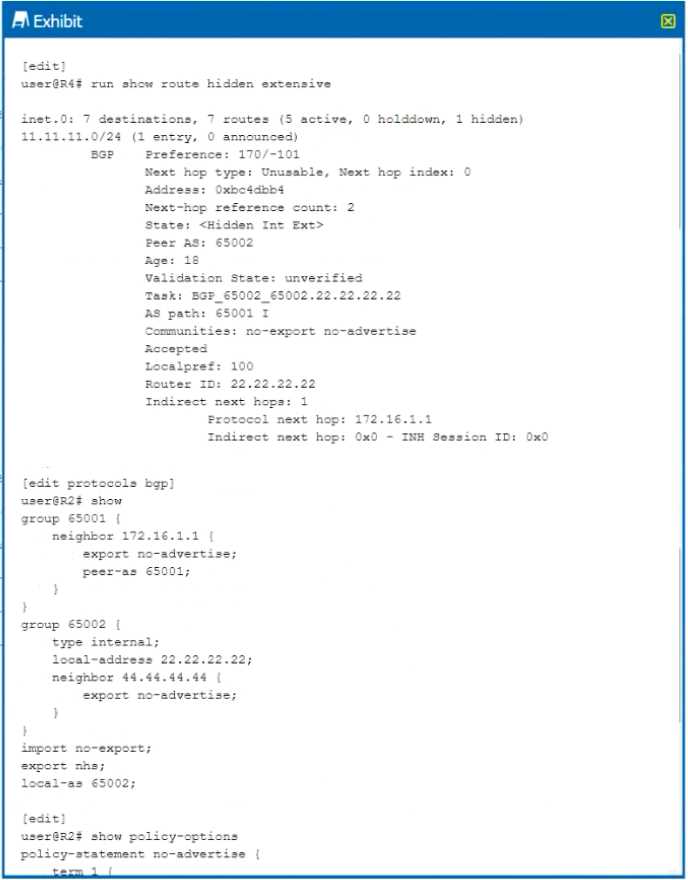
R2 is receiving a route from an EBGP neighbor and is advertising the route to R4
Referring to the exhibit, which configuration on R2 will solve the issue with the route on R4?
- A. Move the ahs policy from a global BGP export policy to an export policy under group 65002
- B. Move the no-advertise export policy from group 65001 to a global BGP policy.
- C. Move the no-export policy from a global BGP import policy to an import policy under group 65001.
- D. Move the no-advertise export policy from group 65002 to a global BGP policy.
Answer:
A